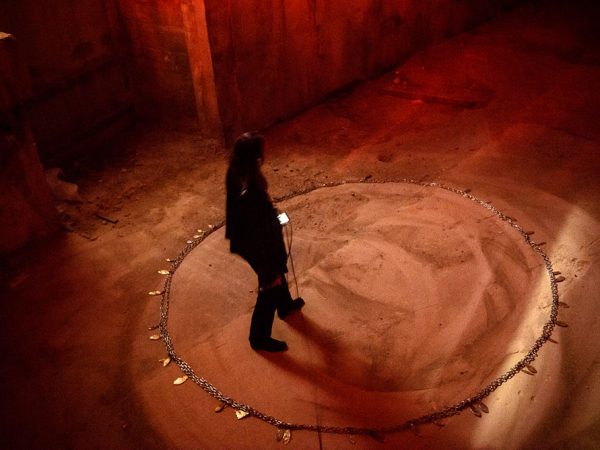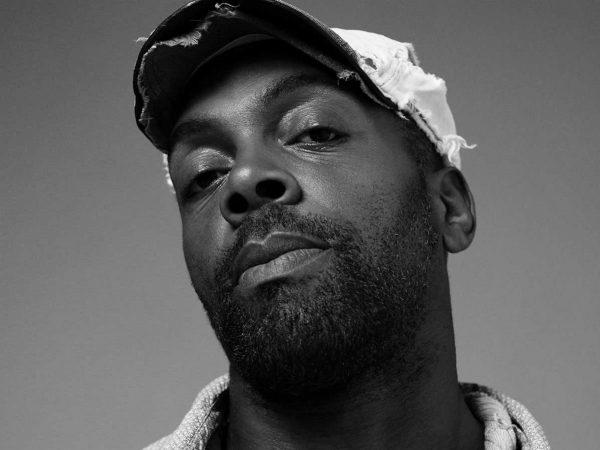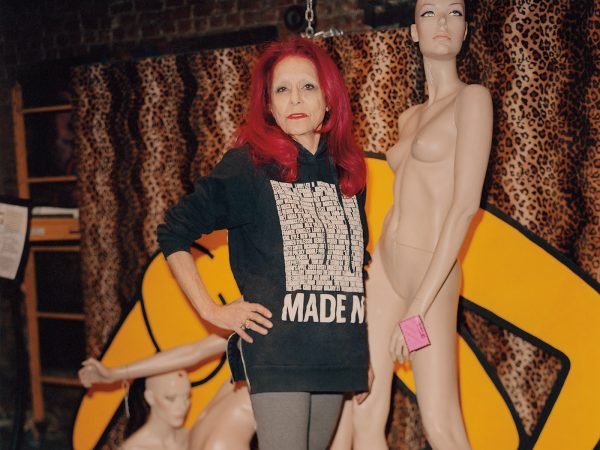William Gibson, arguably the most influential science fiction writer of our time, has envisioned what lies ahead for man, machine, and their integration. His novel Neuromancer is considered a seminal cyberpunk work and has won both the Hugo and Nebula Awards, the most celebrated prizes of the science fiction genre. His ideas—including the inescapability of cyberspace, a phrase and concept he coined, as well as the influence of reality television and virtual reality—have proved nothing short of prophetic.
He’s dabbled in fashion, too. Taking inspiration from the favorite piece of clothing of his post-9/11 novel Pattern Recognition, he collaborated with Japanese label Buzz Rickson’s on a series of clothing and also consults for Arc’teryx Veilance.
Curator Andrew Bolton investigates the very themes Gibson examined in Manus x Machina: Fashion in an Age of Technology, this year’s Anna Wintour Costume Center exhibition at the Metropolitan Museum of Art. Bolton selected more than 150 garments that explore the oppositions between haute couture and ready-to-wear, tracing the divisions between clothes made by hand and those made by machine from the advent of the sewing machine to the present.
Above The Fold

Sam Contis Studies Male Seclusion

Slava Mogutin: “I Transgress, Therefore I Am”

The Present Past: Backstage New York Fashion Week Men’s Spring/Summer 2018

Pierre Bergé Has Died At 86

Falls the Shadow: Maria Grazia Chiuri Designs for Works & Process

An Olfactory Memory Inspires Jason Wu’s First Fragrance

Brave New Wonders: A Preview of the Inaugural Edition of “Close”

Georgia Hilmer’s Fashion Month, Part One

Modelogue: Georgia Hilmer’s Fashion Month, Part Two

Surf League by Thom Browne

Nick Hornby: Grand Narratives and Little Anecdotes

The New Helmut

Designer Turned Artist Jean-Charles de Castelbajac is the Pope of Pop

Splendid Reverie: Backstage Paris Haute Couture Fall/Winter 2017

Tom Burr Cultivates Space at Marcel Breuer’s Pirelli Tire Building

Ludovic de Saint Sernin Debuts Eponymous Collection in Paris

Peaceful Sedition: Backstage Paris Fashion Week Men’s Spring/Summer 2018

Ephemeral Relief: Backstage Milan Fashion Week Men’s Spring/Summer 2018

Olivier Saillard Challenges the Concept of a Museum

“Not Yours”: A New Film by Document and Diane Russo

Introducing: Kozaburo, 2017 LVMH Prize Finalist

Introducing: Marine Serre, 2017 LVMH Prize Finalist

Conscious Skin

Escapism Revived: Backstage London Fashion Week Men’s Spring/Summer 2018

Introducing: Cecilie Bahnsen, 2017 LVMH Prize Finalist

Introducing: Ambush, 2017 LVMH Prize Finalist

New Artifacts

Introducing: Nabil Nayal, 2017 LVMH Prize Finalist

Bringing the House Down

Introducing: Molly Goddard, 2017 LVMH Prize Finalist

Introducing: Atlein, 2017 LVMH Prize Finalist

Introducing: Jahnkoy, 2017 LVMH Prize Finalist

LVMH’s Final Eight

Escaping Reality: A Tour Through the 57th Venice Biennale with Patrik Ervell

Adorned and Subverted: Backstage MB Fashion Week Tbilisi Autumn/Winter 2017

The Geometry of Sound

Klaus Biesenbach Uncovers Papo Colo’s Artistic Legacy in Puerto Rico’s Rainforest

Westward Bound: Backstage Dior Resort 2018

Artist Francesco Vezzoli Uncovers the Radical Images of Lisetta Carmi with MoMA’s Roxana Marcoci

A Weekend in Berlin

Centered Rhyme by Elaine Lustig Cohen and Hermès

How to Proceed: “fashion after Fashion”

Robin Broadbent’s Inanimate Portraits

“Speak Easy”

Revelations of Truth

Re-Realizing the American Dream

Tomihiro Kono’s Hair Sculpting Process

The Art of Craft in the 21st Century

Strength and Rebellion: Backstage Seoul Fashion Week Autumn/Winter 2017

Decorative Growth

The Faces of London

Document Turns Five

Synthesized Chaos: “Scholomance” by Nico Vascellari

A Whole New World for Janette Beckman

New Ceremony: Backstage Paris Fashion Week Autumn/Winter 2017

New Perspectives on an American Classic

Realized Attraction: Backstage Milan Fashion Week Autumn/Winter 2017

Dematerialization: “Escape Attempts” at Shulamit Nazarian

“XOXO” by Jesse Mockrin

Brilliant Light: Backstage London Fashion Week Autumn/Winter 2017

The Form Challenged: Backstage New York Fashion Week Autumn/Winter 2017

Art for Tomorrow: Istanbul’74 Crafts Postcards for Project Lift

Inspiration & Progress

Paskal’s Theory of Design

On the Road

In Taiwan, American Designer Daniel DuGoff Finds Revelation

The Kit To Fixing Fashion

The Game Has Changed: Backstage New York Fashion Week Men’s Autumn/Winter 2017

Class is in Session: Andres Serrano at The School

Forma Originale: Burberry Previews February 2017

“Theoria”

Wearing Wanderlust: Waris Ahluwalia x The Kooples

Approaching Splendor: Backstage Paris Haute Couture Spring/Summer 2017

In Florence, History Returns Onstage

An Island Aesthetic: Loewe Travels to Ibiza

Wilfried Lantoine Takes His Collection to the Dancefloor

A Return To Form: Backstage New York Fashion Week Spring/Summer 2018

20 Years of Jeremy Scott

Offline in Cuba

Distortion of the Everyday at Faustine Steinmetz

Archetypes Redefined: Backstage London Fashion Week Spring/Summer 2018

Spring/Summer 2018 Through the Lens of Designer Erdem Moralıoğlu

A Week of Icons: Backstage Milan Fashion Week Spring/Summer 2018

Toasting the New Edition of Document

Embodying Rick Owens

Prada Channels the Wonder Women Illustrators of the 1940s

Andre Walker’s Collection 30 Years in the Making

Fallen From Grace, An Exclusive Look at Item Idem’s “NUII”

Breaking the System: Backstage Paris Fashion Week Men’s Autumn/Winter 2017

A Modern Manufactory at Mykita Studio

A Wanted Gleam: Backstage Milan Fashion Week Men’s Autumn/Winter 2017

Fashion’s Next, Cottweiler and Gabriela Hearst Take International Woolmark Prize

Beauty in Disorder: Backstage London Fashion Week Men’s Autumn/Winter 2017

“Dior by Mats Gustafson”

Prada’s Power

George Michael’s Epochal Supermodel Lip Sync

The Search for the Spirit of Miss General Idea

A Trace of the Real

Wear and Sniff

Underwater, Doug Aitken Returns to the Real
Bolton discusses the future of fashion with Gibson, questioning if machines could eventually replicate the intricate stitching done by tailors on Savile Row, how fast fashion contributes to a dystopian destiny, and when counterculture style evolves into a mainstream uniform. At his home in Vancouver, the Canadian-American author of Neuromancer was reached by Bolton in New York City.
John Ortved—What are you wearing right now?
William Gibson—Will you tell us what you’re wearing?
John—I absolutely will.
William—OK, I’m wearing Acronym pants, an Arc’teryx sweater, and a puffy Uniqlo vest.
Andrew Bolton—I’m pretty casual today. I’m wearing a pair of Thom Browne chinos, and a pair of Thom Browne wingtips, a Margiela baby-blue crew-neck sweater, and a Prada shirt. I’m fully labeled today!
John—I’m wearing black Nudie jeans and a white American Apparel t-shirt. And I’m at my home office so I’m in my socks. They’re very colorful.
William—Very good!
John—In the most general terms, what do you think about the future of fashion?
Andrew—In the past, whenever designers have thought about the future, it’s a utopian vision of clothing or a dystopian vision. The reality, which I think is highly dystopian, is the idea of “fast fashion.” What’s interesting is that haute couture was established in the same decade that the sewing machine was refined. Obviously there was a reaction against the sewing machine; the reliance on the hand was a sort of fear of the machine. Fear and clothing are things that are very related.
When people present images of the future, it’s often images that are directly culled from superhero fiction. Often presenting a very idealized body. The superhero is really about transformation; it’s about the power of clothing to transform the body. In a way, the superhero can be a metaphor for fashion.
William—Yes, I think of the skin-tight jumpsuit, as well, as being the heroic Grecian sculpture of a prudish culture. With Superman or Batman, they’re heroic beyond needs; you can see their muscles, but you can’t see their genitals.
One of the things that frustrated me with science fiction even as a child was the lack of specificity. And one of the ways it lacked specificity was in terms of what everyone was wearing. The future clothing really was never described. Decades later when I actually tried to write it myself, I made a point of describing in some detail what the characters were wearing. For the most part I found my imagination suggesting that what they were wearing wasn’t anything that we would find that remarkable. Characters tended to be wearing jeans and leather jackets and virtually anything but skin-tight jumpsuits.

One of the things that frustrated me with science fiction even as a child was the lack of specificity. And one of the ways it lacked specificity was in terms of what everyone was wearing. The future clothing really was never described.
John—The jumpsuits. It’s everybody wearing the same thing: uniforms.
William—It seems to me that over the course of the 20th century, the really, really serious uniforms were on Wall Street, where a minute detail of fashion could make a difference. You go through that thing where menswear was so incredibly conservative that a quarter of an inch difference in tie width could communicate attitudes. We’ve never had that again. If nothing else, “fast fashion” has saved us from that! Although I don’t know, I sort of liked it. It was so perverse.
Andrew—I think that with mainstream menswear in particular it’s often defined by a sort of denial of the individual. It was something that was very much established after the great industrialization of the late 18th, early 19th century, where the idea of uniformity was something that was enforced within men’s clothing. In the 60s and in the 80s, the parameters of menswear were expanded through this notion of visibility, often within subcultural movements—music in particular.
I’m completely beguiled by uniforms; I’m very attracted by the idea of a room full of everyone dressed the same. I just think it’s so beautiful and interesting to look at, and perhaps uncomfortable or unsettling to come to terms with.
John—Mr. Gibson, any thoughts on that: a room full of people dressed the same way?
William—Well, I think I actually see it quite a lot! Anyone violating the language of dress is left very much outside of what’s happening in that room. I think we are an extraordinarily conservative species that way. It’s also not limited to our culture; it can be the color of the flecks in one’s Harris Tweed or the length of one’s penis sheath, but it still matters. If you’re missing your Harris Tweed or missing your penis sheath, you’re really not supposed to be there.
I’ve never been attracted to the uniform as an aspect of militarism, but I have been very attracted to military design, at least in the 20th century, as a kind of epitome of modernism—an embrace of functionality, whether symbolic representation or badges of rank. I’ve never been attracted to dress uniform, only fatigues: combat gear, pilot’s jackets, and things like that—and outside of the original context.
John—When we think of how we will make our clothes in the future, do either of you see any real place for hands, or will it all be machines?
William—I was about to ask a question myself about that. We are right now, I think, poised on the edge of a much more seriously robotic world. There are robots right here in my city performing the most delicate surgeries imaginable. They can do it better than the human hand. What I’m wondering is: what happens when they reach Savile Row and Jermyn Street? And what happens when that reaches the factories in Malaysia that knock-off the designer houses? It’s probably bound to happen because the robots will get cheaper, and you’ll have robots that can make 50,000 random stitches making the pattern on the front of that jacket, exactly the way some guy in a back room in Liverpool could do it.
Andrew—I think the machine has always played a role, particularly if you think about the tool as being a machine—which I do. However, it’s often still directed by the human hand. Even when it comes to designs that are entirely designed by the computer, the code is still human.
Often, as with any artistic practice, there is so much beauty and so much development out of errors. Some of the most beautiful creations I know of were the result of human error. I wonder if a machine is capable of making an error or capable of making a mistake to the point where it enhances or establishes a new creative language or vocabulary. There’s a quote from the science-fiction film, Metropolis that says: “The gap between the hand and the machine is the heart.” Usually the handmade is seen as something that is exclusive, luxurious—that individuality. Whereas the machine is about democracy, inferiority, and dehumanization. I don’t think those values have ever been applicable. William, can you see a moment in any creative process—whether it’s fashion, design, writing—where a machine will take away all of that creative endeavor in any discipline?
William—Well, it’s actually easier for me to imagine it with design. With writing I draw a blank. I suggested that robots might do the hand labor of Savile Row. I think that it’s possible. I don’t know whether it would be a good business proposition. I think that we have a cultural idea that the gap between the hand and the human heart needs to connect to make a really great garment. I don’t think we have to worry about computers actually designing our clothing, except garments that are, in a technical sense, exclusively functional. I don’t imagine that they would be expressive of humanity in the way you expect remarkable garments to be. Although I do think it would be possible to program a great deal of clothing language that has its roots in human emotion and imagination.
John—Mr. Gibson’s cyberpunk aesthetic is discussed as the last potential counterculture—that dressing any other way is too easily absorbed by commerce. In the future, will it be possible to dress against the establishment? Or is that something that disappeared in the 60s?
William—I think that’s a very good question and I never had much of an answer for it. I think that bohemians were the dreamtime of industrial civilization. Bohemians were the imagination of the world from the 1850s on and all bohemians had incredibly uniform dress codes. Remarkably. Excuse me…I lost that. I’m going to leave that one there.
Andrew—The paradox of subcultural styles is that they start off by being anti-establishment and about individuality; they very quickly become a code or uniform within that. I think what I have always found so attractive about subcultural movements is the DIY aspect. People talk about 3D printing—it’s extraordinary, the idea that you have a garment you print and that can be designed specifically to your proportions. To me that is the ultimate couture. The one thing I find a little disappointing about technologies like 3D printing is that it still gets used to create very conservative fashion, like a dress, skirt, top, coat, pair of trousers. I wish that perhaps it could be used to question the components of dress.

The paradox of subcultural styles is that they start off by being anti-establishment and about individuality; they very quickly become a code or uniform within that.”
William—The most interesting technology I’ve seen for producing garments recently is a kind of digital printing that allows you to order an individual garment printed with whatever you want. You can have dragon scale on your hoodie sleeve and a munchkin head on the back of your hoodie. Literally anything at all, and I’ve given just two horrible examples. The idea of what someone might do with that is just extraordinary. I think we will see a few more technologies like that come along. Those are the things you can’t describe in a science fiction novel in any great detail, because it simply becomes catalogue. I’m dangerously prone to cataloguing in my own fiction. I go off on rants about what the characters might be wearing.
John—What about interactivity with apparel and accessories? What’s the future of the function of fashion?
Andrew—When one thinks about clothing, one thinks it has to be functional, and of course it does to an extent, but I’m really interested in expanding the parameters of fashion conceptually. I don’t really want a jacket that will tell me how hot I am, because I invariably know how hot I am and take my jacket off. I think where it does have a future is in medicine and sport, when it’s specifically related to a function. What gets lost most often in that are aesthetics. When it comes to environmental concerns, which is a very valid topic in fashion, invariably the aesthetics are missing.
John—In terms of consumer goods, there may not be a larger polluter than the apparel industry. Do you think there is a way for fashion to evolve where it can address those concerns?
William—I don’t think it’s impossible, but with everything else it’s a matter of finding the political and economic wherewithal to do things in a less destructive fashion. I think that we could, but I don’t know that we necessarily will.
Andrew—I agree, there needs to be a big philosophical shift in terms of the production of fashion to address the environmental concerns in a very realistic way. There are designers who are making inroads into that—Stella McCartney, for example. It’s also happening on a more experimental level: designers are creating biodegradable materials. But the technology isn’t quite there yet. I think, going back to your first question, John, the future of fashion is actually going to be about more collaboration. Designers need to start working with scientists and biologists and computer technicians, then I think we’re onto something more real at every level.
William—I recently found an amazing documentary about what happens to discarded clothing when it reaches India. It’s all ripped up so it can’t be resold. Often they sort them into piles by color. It gets rewoven into yellow or blue or red fabric. It has this other life. And in some sort of really utopian world, the people who design it for us are aware of their connection through the entire global system. Our sense of what clothing is, where it lives, and how long it lives is so skewed; people think that it’s acceptable to throw clothing away after wearing it once.
Andrew—The idea of recycling clothing is huge. People are wearing something once or twice—that’s the danger of fast fashion. The idea of having a second life is something that needs to be explored in greater detail. Again it’s about education.
John—As we move forward, we see fashion in a new way, literally, through new media. Does it and will it change the way fashion is designed?
Andrew—I think it has actually. I was talking to a designer the other day who was creating a collection, specifically keeping in mind how it would look on the iPhone. There is a wonderful story about the Duke of Windsor, who preferred to wear midnight blue for tuxedo because he felt it photographed so much better than black. I think we’ve always been aware of the flashbulb scenario, but absolutely I think how fashion is being received has very much had an impact on fashion creation, not just fashion production. Often the history of fashion is really the history of fashion photography. I’m always surprised when I go to fashion shows and in the front row you see big editors looking at the fashion through their iPhone. With Instagram and everything else, fashion has become very much about consumption, and—unfortunately in my mind—it has absolutely affected the creation of fashion.
William—I’m deeply sure that we aren’t able to know exactly how it was. I think that when you take up a new communication platform, you choose that platform and it becomes incredibly difficult to get back to what came prior. There are only a few accounts of what happened in New York in the early days of broadcast television. Those who did describe it said that people quit sitting out on the steps, and the life of the street changed dramatically, and it never went back to what it was prior to television. You can’t remember. I think it’s incredibly difficult for us to imagine what music would be like in a world prior to when music could be recorded. You don’t know those things. I think similar things happen with technologies like the iPhone. We’re a part of the change, and once you’re there you don’t know what it was previously.
Andrew—I think the advantage of technology in terms of the perception of fashion is that more people are seeing it, which is fantastic. It’s almost like a level playing field in terms of the way people have increased access to it. That to me is a huge advantage of technology.
John—Is it necessarily fantastic? As fast fashion grows, is it necessarily a good thing that more people are seeing this and wanting to consume it?
Andrew—I’m not a great fan of fast fashion, but I’m a great fan of accessibility. That’s what I think is fantastic, the democracy and the access. At one stage fashion shows were seen by a few fashion editors on runway shows. Now people can access them any time of day and quickly in real time. That’s wonderful. I find fast fashion a rather dystopian view of the future of fashion. It’s a reality but it’s not something I find exciting on many levels.
William—I agree completely with Andrew. I think the democratization and access is excellent and is an excellent antidote to the dystopian side of fast fashion. I think that more people being able to have access to wearable art can only be a good thing. It’s educational.
John—I think we can all agree: we hope the future of fashion is slow!
Andrew—Exactly.
Manus x Machina: Fashion in an Age of Technology at the Anna Wintour Costume Center of the Metropolitan Museum of Art, 1000 5th Ave, New York, NY, is on show until August 14, 2016. William Gibson’s latest novel, The Peripheral, is available in stores now.





















